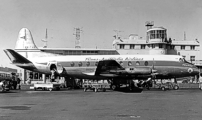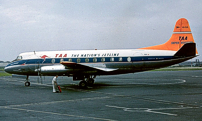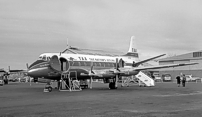
November 1954 to October 1962
Trans-Australia Airlines (TAA)
VH-TVB - c/n 45 - a V.720 series Viscount
Australia registered
June 1952
This was the second Type 720 of six ordered by Trans-Australia Airlines (TAA).
The total value of the order was £1,934,000 including spare parts.
Production Aircraft No. 40 - the 40th production Type 700 series Viscount built,
was the 8th Viscount fuselage assembled at Hurn, Bournemouth, Hampshire, England,
and the 15th Viscount assembled at Hurn, Bournemouth, Hampshire, England.
Production Order No. F02/720. Sales Order No. F02/88A. Stock Order No. F14/21B.
13 March 1954
Fuselage assembly commenced at Hurn Airport, Bournemouth, Hampshire, England.
29 April 1954
Fuselage to Erecting Shop 'E' at Hurn Airport, Bournemouth, Hampshire, England.
22 June 1954
Registered to Australian National Airlines Commission trading as Trans-Australia Airlines (TAA).
20 October 1954
First flight from Hurn Airport, Bournemouth, Hampshire, England.
 Viscount illustrations by David Carter Viscount illustrations by David Carter
25 November 1954
Departed from Hurn Airport, Bournemouth, Hampshire, England on delivery to Trans-Australia Airlines (TAA) named as 'Gregory Blaxland'.
Included in the delivery crew were Captain Manning, Navigator D Lawrence, and Radio Operator Hobbs.
It was fitted with Rolls-Royce Dart RDa3 Mark 505 engines, which were later upgraded to Mark 506 standard.
4 December 1954
Arrived at Essendon Airport, Melbourne, Victoria, Australia.
12 December 1954
Entered TAA servce from Essendon Airport, Melbourne, Victoria to Kingsford Smith Airport, Mascot, Sydney, New South Wales, Australia and return.
13 December 1954
Departed from Essendon Airport, Melbourne, Victoria on a demonstration flight to Eagle Farm Airport, Brisbane, Queensland, Australia which took 3 hours 13 minutes.
16 February 1955
Landed at the newly opened West Beach Airport, Adelaide, South Australia as the first turbine powered aircraft to do so.
The flight originated from Essendon Airport, Melbourne, Victoria with Captain Manning and First Officer McDougall.
24 May 1955
Total airframe time recorded as 1,216 hours.
1955
This aircraft broke the Melbourne to Brisbane journey time record. The 858 nautical mile sector was achieved by an unknown Captain in 2hrs 27 minutes.
10 July 1955
Set a new 'type' record for a flight from Cairns Airport, Queensland to Townsville Airport, North Queensland which took 38 minutes. Later on the same day another 'type' record was set between Townsville Airport, North Queensland to Eagle Farm Airport, Brisbane, Queensland which took 2 hours 5 minutes. Both flights were flown with Captain H Gray in command.
23 December 1956
Set a new 'type' record for a flight from Launceston Airport, Tasmania to Essendon Airport, Melbourne, Victoria which took 48 minutes with Captain R D Winch in command.

Converted to a V.720C
circa 1957
Converted to Type 720C standard with a revised cockpit layout that included replacing the slatted direct vision windows, paddle type propeller blades and propeller synchronisation equipment.
14 August 1957
Set a new 'type' record for a flight from Townsville Airport, North Queensland to Eagle Farm Airport, Brisbane, Queensland which took 1 hour 54 minutes with Captain C A Howard in command.

Trans-Australia Airlines (TAA)
'Orange Tail' livery
circa 1959
Painted in the Trans-Australia Airlines (TAA) 'Orange Tail' livery.

Trans-Australia Airlines (TAA)
'White Tail' livery
circa 1961
Painted in the Trans-Australia Airlines (TAA) 'White Tail' livery.
circa 1962
Weather radar was installed as a result of the accident to VH-TVC (C/N 46) and a subsequent Australian Airworthiness Directive.
7 July 1962
Leased to Ansett-ANA in full livery.
|



